|
|
|||
|
|
|||
Back to Preceding Week; on to Next Week
|
THIS TIME, IT'S LEUCISTIC Little did we know when we posted our recent account of a rare white Ruby-throated Hummingbird in Chapel Hill NC that it would generate such interest around the country on birding listservs, in newspapers, and even through a nationally syndicated broadcast of Here & Now on public radio. Banding the Albino Hummingbird has been our most popular installment of This Week at Hilton Pond to date, with more than 6,000 hits over the past two weeks and more visitors surfing in every hour. (Curiously, our second-most-popular installment was about a partial albino deer that visited Hilton Pond last Christmas. Maybe folks just have a thing for animals with unusual colors--or lack of them.) Due in part to the albino hummingbird posting, we've received numerous e-mails about other white hummers in the U.S. and Canada. One report--from Barry Benton in Bethany SC and less than a dozen miles from Hilton Pond Center--prompted us to take a short drive to see a bird that this time wasn't an albino, it was leucistic. 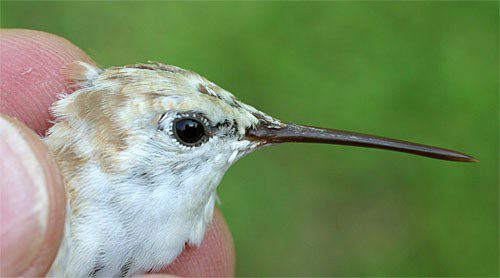
All text & photos © Hilton Pond Center A true albino hummingbird has snowy white plumage and its legs, bill, and eyes are pink. Barry Benton noticed that these parts on his Bethany hummer were dark even though it had light-colored feathers. Thus, he suspected from the start that his bird was "leucistic"--able to produce some degree of pigment but not laying down melanin to give its feathers a normal appearance. When we arrived at Barry's home on 24 August, a pale-colored hummingbird was perched in full view atop a Flowering Dogwood. Barry's hummingbird had been visiting his two front porch feeders since 19 August, and within a few days it was the dominant hummer in the yard. Because it repeatedly chased any normal ruby-throat that approached a feeder, we were confident we could catch the pale bird without too much trouble. Indeed, the leucistic hummer took only a couple of sorties to decipher how to get at the feeder inside the trap; we had the bird in hand in less than ten minutes,and it most definitely was leucistic. Up close, we were struck by how similar Barry's white hummer was to a couple of other leucistic ruby-throats we have banded. In particular, the base of the tail had a pale brown cast (above right) that would have looked green in a normal hummingbird; in addition, the white tail tips typical of normal female and young male ruby-throats were plainly visible. Although Barry's bird lacked some plumage cues to its age and sex, we determined it was a female because of the rounded tip on her sixth primary wing feather, which would be pointed in a male. Since the upper bill was covered by tiny etchings--"corrugations" that disappear over six months or so--we aged it as a youngster that fledged sometime in 2003. 
All text & photos © Hilton Pond Center The Bethany bird's crown and nape were nearly the same tan color as its tail, but one curious aspect of its coloration was the buff-colored tips on back feathers that otherwise were white (below left). Most juvenile Ruby-throated Hummingbirds with normal plumage also show buffy tips on the back (below right), but the rest of their melanin-laden wing and dorsal plumage appears green when microscopic air bubbles and grooves scatter and refract the light. This implies that the buff, tan, and brown feathers of the leucistic bird--and even normal ruby-throats--are caused by a pigment other than melanin, or perhaps by colored oils. 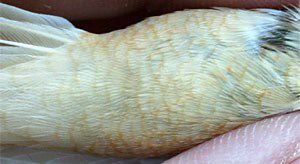 .. ..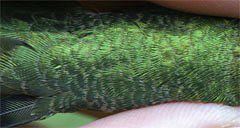
All text & photos © Hilton Pond Center One interesting thing we've noted on some leucistic birds we've banded is a dark area along the outer edge of the folded wing. We were puzzled by this anomaly until we handled the true albino in Chapel Hill; that bird also had a wing spot, but it was pink. This made us realize the spot-- which we now know is called a "subalular apterium"--was bare skin showing through. The apterium appears blue-black in normal ruby-throats whose skin is dark (below right), but in the leucistic bird from Bethany it was a rich brown color. 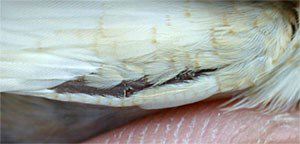 .. ..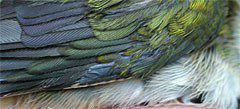
All text & photos © Hilton Pond Center This same brownish hue of the apterium was present and even more noticeable in the leucistic bird's almost translucent bill (below left), which was much paler than the shiny black of a normal Ruby-throated Hummingbird. And . . . 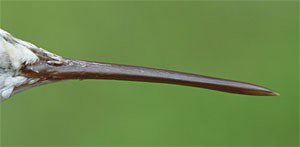 .. ..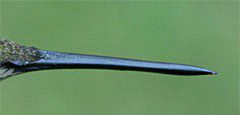
All text & photos © Hilton Pond Center . . . when we grasped the leucistic bird's toes to apply the band (below left), the claws and the feet were this same warm shade of brown--much lighter than the black legs of a normally pigmented ruby-throat. 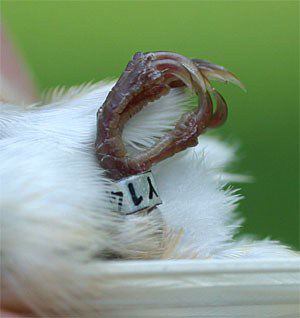 .. ..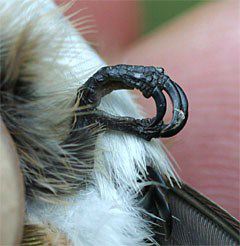
All text & photos © Hilton Pond Center Although we've received a relative flood of white hummingbird reports since we wrote about the Chapel Hill albino, we don't think there's any sort of epidemic. It's probably just that more people are feeding hummers and those folks are now more aware of how to report unusual sightings. The 2003 hummingbird season is far from over, so we hope the public will continue to let us know about birds with unusual plumage by writing to our Research mailbox at Hilton Pond Center in York SC. If you live near us, we'll try to visit to verify and band your bird; if you're far away, we'll attempt to find a bander who may be closer to you. In any case, we hope sometime soon you get to experience the same thrill that Barry Benton felt when he released his white hummingbird--this time a leucistic one. 
All text & photos © Hilton Pond Center Please e-mail additional reports of white hummingbirds to RESEARCH. If you enjoy "This Week at Hilton Pond," please help Support Hilton Pond Center for Piedmont Natural History. It's painless, and YOU can make a difference!
|
||||
| Donate a portion of your purchase price from 500 top on-line stores via iGive: |
 |
|||
| Use your PayPal account to make direct donations: |
|
|||
 Please report your sightings of Please report your sightings ofColor-marked Ruby-throated Hummingbirds |
|
SPECIES BANDED THIS WEEK: * = New species for 2003 WEEKLY BANDING TOTAL 5 species 22 individuals
YEARLY BANDING TOTAL (2003) 46 species 804 individuals
BANDING GRAND TOTAL (since 28 June 1982) 123 species 42,918 individuals
NOTABLE RECAPTURES THIS WEEK (with original banding date, sex, and current age) None this week
VAGRANT HUMMINGBIRDS None this week |
OTHER SIGHTINGS OF INTEREST --After an extremely mild summer (only three days at 90 degrees or above for the nearby Charlotte NC airport), the thermometer slipped into the mid-90s three days in a row this week, with VERY high humidity. Ruby-throated Hummingbird activity became nearly non-existent at Hilton Pond Center; only two new hummers were banded during the three hottest days, even though the last week of August should begin our busiest three weeks of hummingbird banding. By 28 Aug we had banded 87 ruby-throats for 2003--about 95% of our 20-year average by that date. Without a major influx during migration, it appears we'll be nowhere near our record of 197 new hummers set in 1995. We're hoping that because of our cool and stormy spring, hummingbird phenology in the eastern U.S. is just running a week or two behind in 2003. |
 "HUMMINGBIRD MORNINGS" "HUMMINGBIRD MORNINGS"In 2004, informative and entertaining hummingbird banding presentations are already scheduled for Virginia, North Carolina & Kentucky/Tennessee. (Click on the logo at left for details.) If your group would like to host "Hummingbird Mornings" anywhere in the U.S. or Canada in 2004 or later, contact Bill Hilton Jr. |
|
Up to Top of Page Current Weather Conditions at Hilton Pond Center |
 post questions for The Piedmont Naturalist |
Join the |
Search Engine for |
|
|